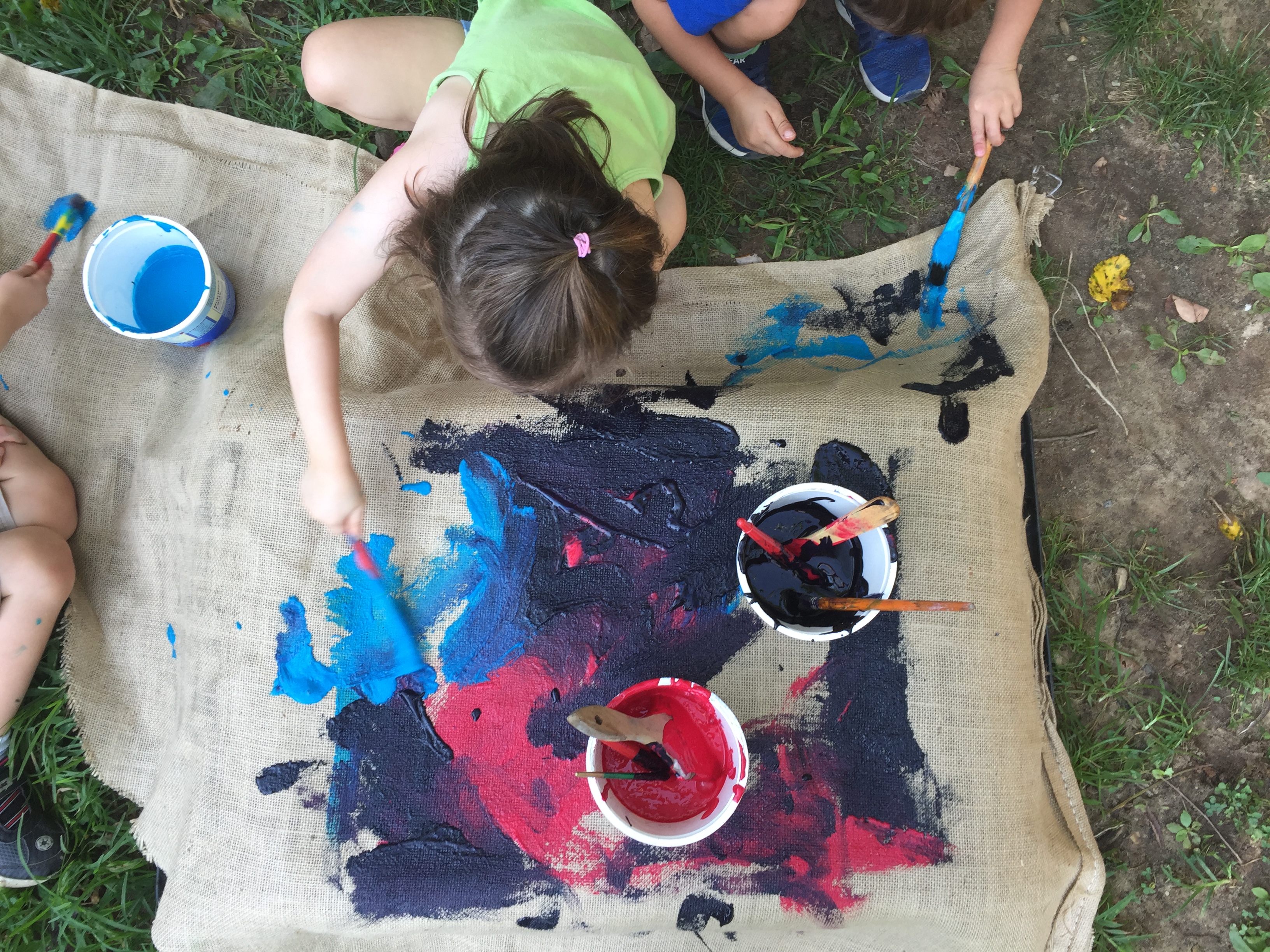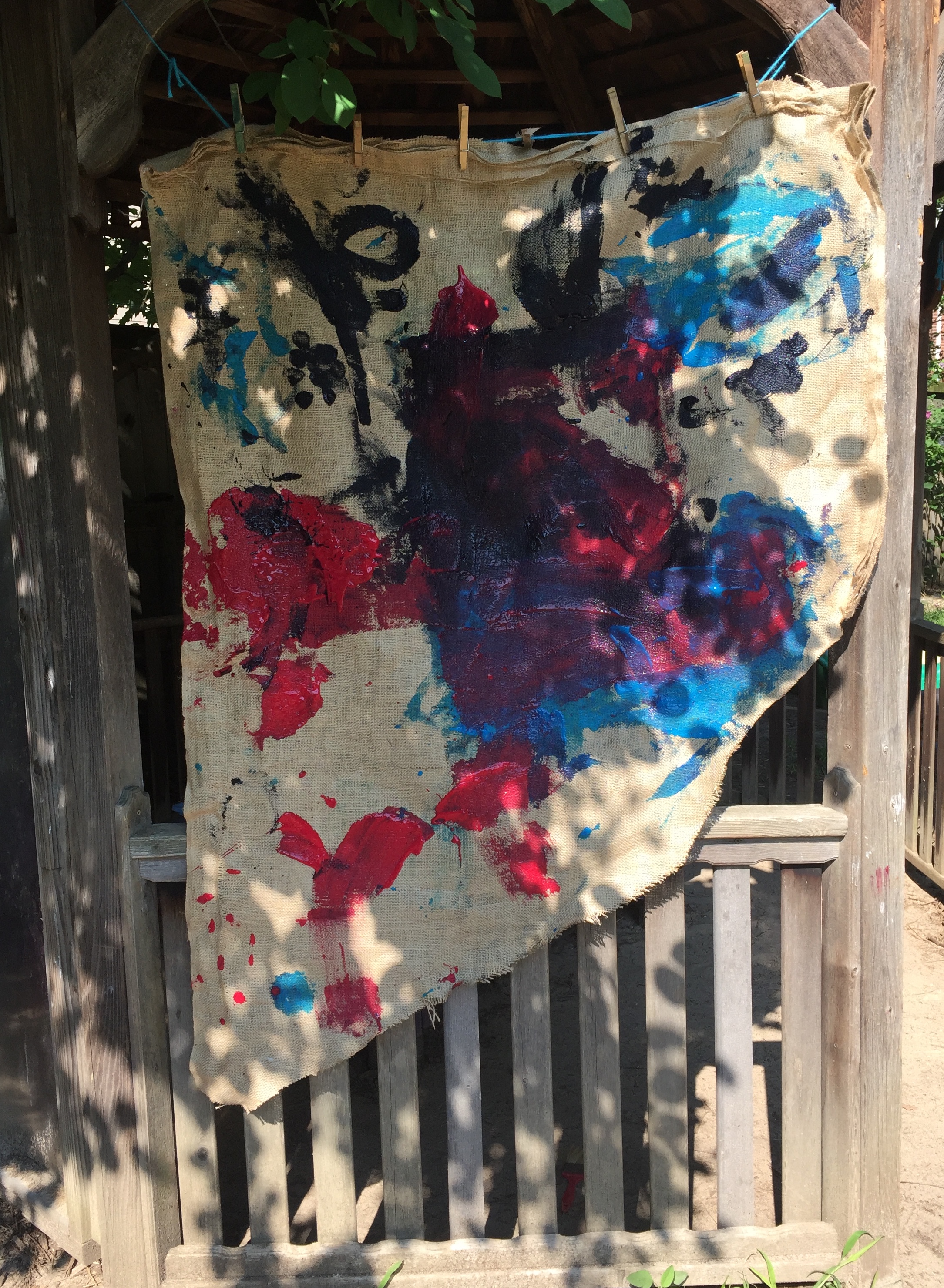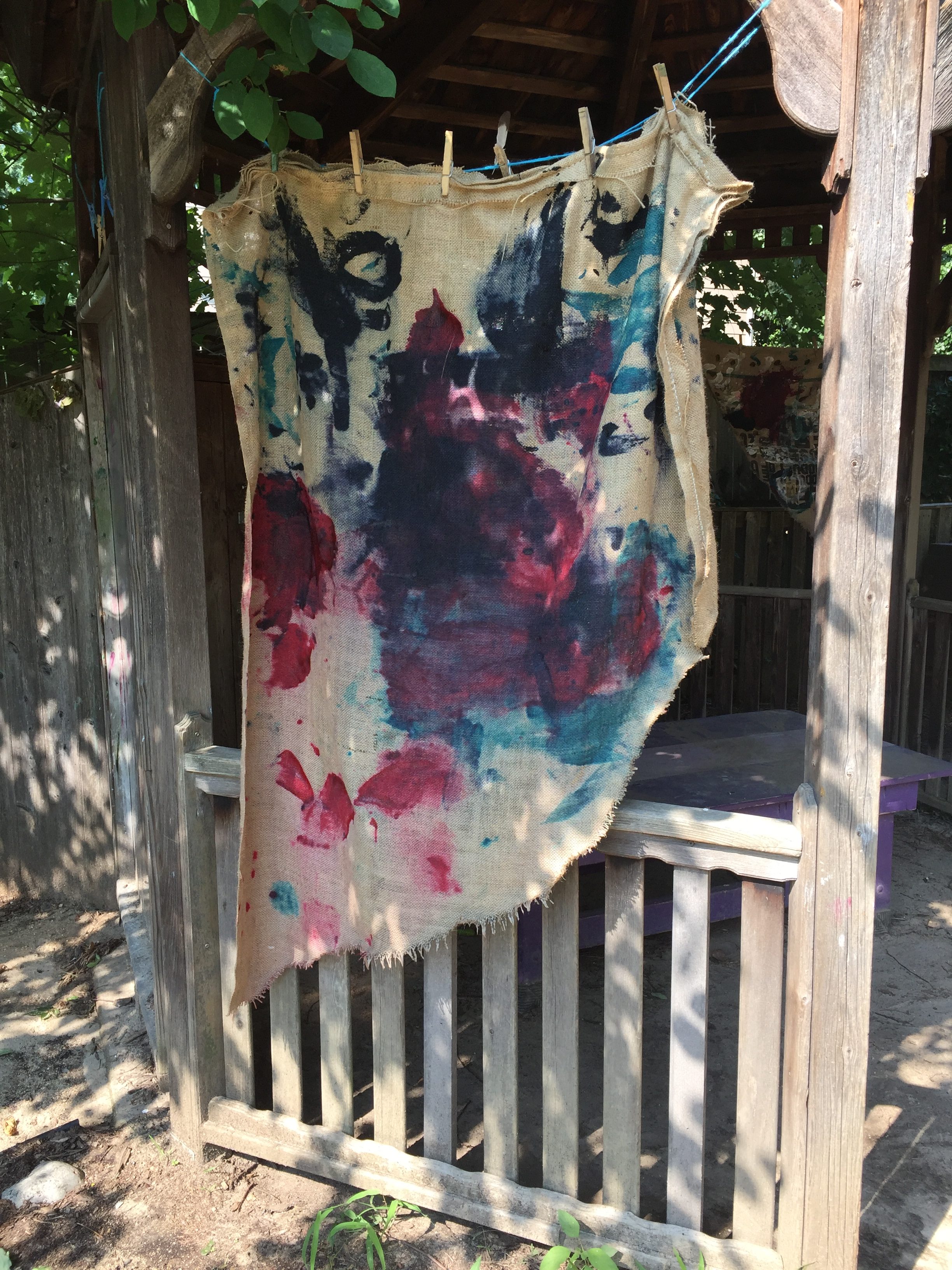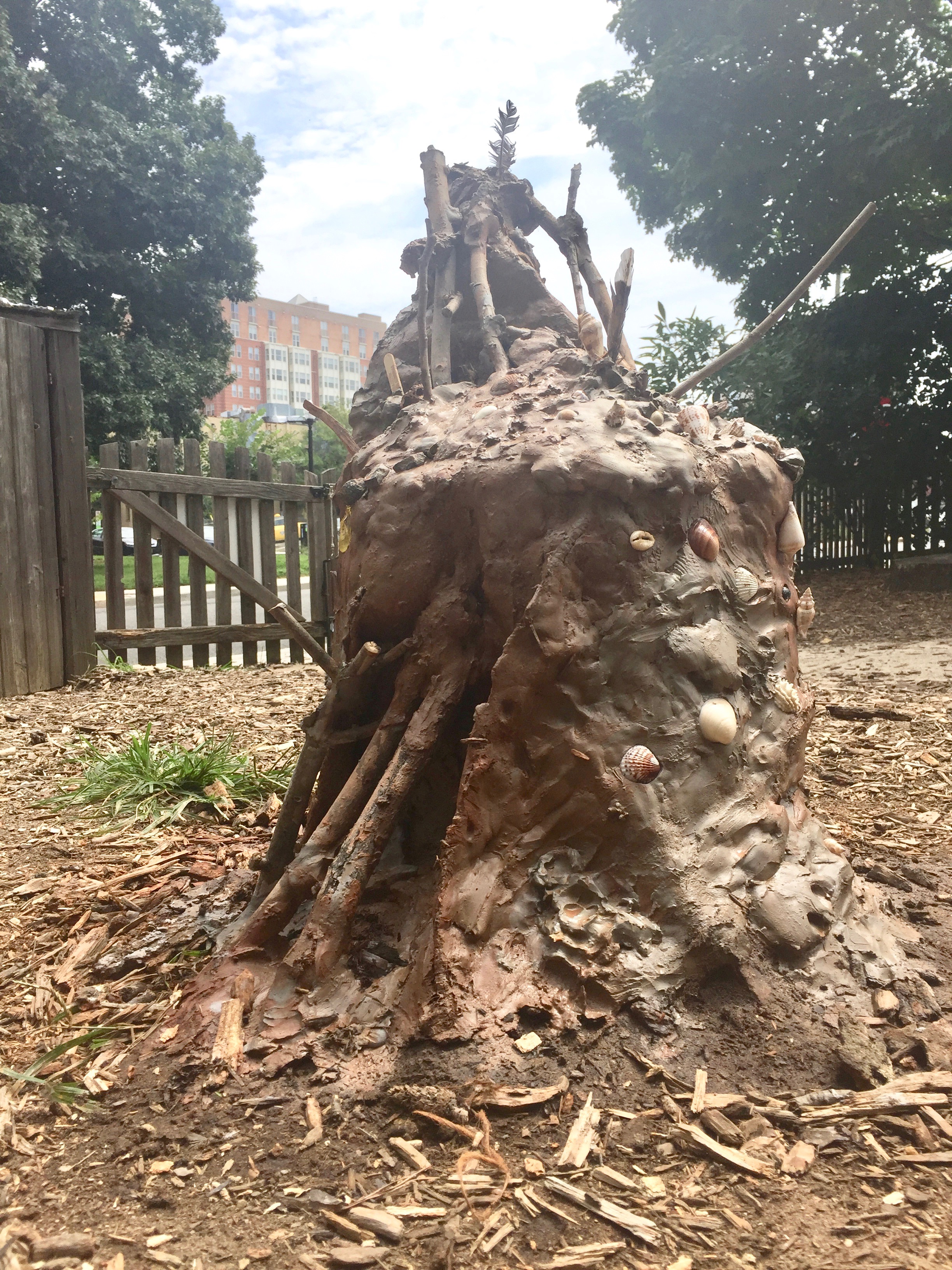Ephemeral art exploring properties of matter, natural materials
By Peggy Ashbrook
Posted on 2018-08-31
 I had fun this summer spending 4 days over 2 weeks “enriching” preschool teachers and children in their program by collaboratively exploring ephemeral art projects. Good discussion about when children’s making becomes art was part of our work together. Does mixing up a colorful mud-grass-flower-water “stew” or chopping (sculpting?) a rotting log with plastic trowels count as art? What do you think?
I had fun this summer spending 4 days over 2 weeks “enriching” preschool teachers and children in their program by collaboratively exploring ephemeral art projects. Good discussion about when children’s making becomes art was part of our work together. Does mixing up a colorful mud-grass-flower-water “stew” or chopping (sculpting?) a rotting log with plastic trowels count as art? What do you think?
 While experiences and subsequent discoveries are important, I don’t call it art unless the children are intentional about designing the look, smell, feel, or sound of it. Or if they identify some intentions afterwards (“It looks like a…”). I can see the science learning in children’s random and open exploration actions but I wouldn’t call these art. The open-ended work builds understanding as they make connections between prior experiences and accidental discoveries. In the stew the stones sink, flowers float, and the water gets more opaque as soil is added. Petals are easier to tear apart than stems, each contributing a different color and texture to the mix. As the rotting log comes apart, the inner color is lighter than the outside…”Why?” “I think it’s because the rain.”
While experiences and subsequent discoveries are important, I don’t call it art unless the children are intentional about designing the look, smell, feel, or sound of it. Or if they identify some intentions afterwards (“It looks like a…”). I can see the science learning in children’s random and open exploration actions but I wouldn’t call these art. The open-ended work builds understanding as they make connections between prior experiences and accidental discoveries. In the stew the stones sink, flowers float, and the water gets more opaque as soil is added. Petals are easier to tear apart than stems, each contributing a different color and texture to the mix. As the rotting log comes apart, the inner color is lighter than the outside…”Why?” “I think it’s because the rain.”
 The ephemeral art work included painting with water, temporary structures of rock, sticks set into sand and their shadows, painted leaves and burlap, and a clay structure embellished with shells and sticks. Discussion with the children as they worked let them know that some art work we make doesn’t get saved to take home. Our photographs can “save” the work for us before “unbuilders” disrupt it or time and natural weather events make changes.
The ephemeral art work included painting with water, temporary structures of rock, sticks set into sand and their shadows, painted leaves and burlap, and a clay structure embellished with shells and sticks. Discussion with the children as they worked let them know that some art work we make doesn’t get saved to take home. Our photographs can “save” the work for us before “unbuilders” disrupt it or time and natural weather events make changes.
 The children built “bridges” using different shapes and types of rock, exploring the properties of rock and how shape affects how a rock can be part of a structure. The rocks provided a different kind of experience but required close supervision as this new-to-the-school material was heavier than most others usually available (I asked children to use two hands to lift the rocks). My hope is that with experience, some classes at the school will be able to incorporate the stones into the sandbox play.
The children built “bridges” using different shapes and types of rock, exploring the properties of rock and how shape affects how a rock can be part of a structure. The rocks provided a different kind of experience but required close supervision as this new-to-the-school material was heavier than most others usually available (I asked children to use two hands to lift the rocks). My hope is that with experience, some classes at the school will be able to incorporate the stones into the sandbox play.
 Children and teachers were surprised that we could paint on leaves picked from trees. The smooth Redbud tree leaves made mini canvases. We pinned them up on a wall and the images changed with time, sunlight, and rain. I was relieved when the children did not get upset at the changes—they accepted the idea of ephemeral more easily than I expected.
Children and teachers were surprised that we could paint on leaves picked from trees. The smooth Redbud tree leaves made mini canvases. We pinned them up on a wall and the images changed with time, sunlight, and rain. I was relieved when the children did not get upset at the changes—they accepted the idea of ephemeral more easily than I expected.
Burlap bags, donated by a local coffee roaster, worked well for two purposes: a painting canvas and base for a structure/sculpture. I thought a group experience painting with tempera might make children less concerned about having their work changed by leaving the canvas hung up outside over a week of rainstorms and sunshine. Adding more paint was the main point for many but a few children focused on where they added paint. Changes to the work will be easy to notice when comparing photos of newly-created work with photographs taken weeks later.
Three, four, and five-year-olds contributed their ideas and effort to creating a structure using a stump and sticks covered with burlap as the base. Children and teachers pressed gray potters clay into the burlap, wetting it to make it stick. On a nearby stump they used play kitchen knives to cut up slabs of clay, switching to a spatula action, pressing and rubbing when adding the clay to the structure. Once all available clay became part of the structure (I still hesitate to call it a sculpture), children began embellishing it with sticks and stones from the play area and shells from someone’s beach vacation.
Teachers talked with children about observed changes in the paintings due to leaves drying and curling, and rain streaking the paint as it soaked the burlap canvas. “Oh, okay,” was the reaction of most children. Perhaps because they were more intimately involved with the structure through their hands-on manipulation of clay, they earnestly called teachers’ attention to cracks forming as the clay dried, and discussed whether or not to pick it apart. (Opinions were divided so teachers said the plan was to keep it intact.) After a heavy rain re-softening and drooping the clay covering the burlap, children added more shells and sticks, making the structure more of a sculpture in my eyes.
With more clay, sand, straw, and more time, children could make a larger, more permanent sculpture using a “cob” process. “Always Becoming,” by artist Nora Naranjo-Morse (Santa Clara Pueblo) is an example of sculptures that change over time as they stand in the elements outside the National Museum of the American Indian in Washington, D. C.
The play area is open to the public after school hours so it is unlikely the sculpture structure will survive very long. The children will retain their experiences of the absorption of paint into burlap, texture of leaves, blocking light to create shadows, clay becoming slippery with water, pushing clay between the burlap fibers, sticks and shells sticking into clay, and rain altering clay. These experiences help them build their understanding of the properties of matter, structure of leaves, shadows, effects of weather events, and the idea that they can manipulate matter to create artwork, or something.
Disclaimer: The views expressed in this blog post are those of the author(s) and do not necessarily reflect the official position of the National Science Teaching Association (NSTA).













